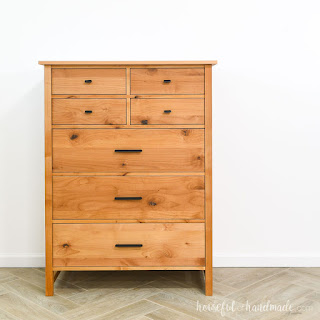Organize Your Home with Elegant Dresser Woodworking Plans
The allure of handcrafted furniture extends far beyond mere aesthetics. A meticulously crafted dresser, built with your own hands, offers not only a statement piece for your home but also a deeply satisfying experience of creation and a solution to often-overlooked organizational challenges. This article delves into the intricate world of dresser woodworking plans, providing comprehensive guidance for aspiring artisans seeking to construct an elegant and functional addition to their living space.
Choosing the Right Dresser Design
Before embarking on the construction process, careful consideration must be given to the dresser's design. Numerous styles exist, each offering distinct advantages and demanding varying levels of woodworking expertise. The choice should reflect not only personal aesthetics but also the available space, the intended purpose, and the builder's skill level.
Traditional Styles: A Timeless Appeal
Traditional dresser designs, characterized by their classic lines and ornate detailing, often incorporate features like intricate carvings, multiple drawers of varying sizes, and robust construction methods. These designs, while visually stunning, typically require advanced woodworking skills and meticulous attention to detail. Popular examples include:
- Queen Anne style: Featuring cabriole legs, shell carvings, and often a serpentine front.
- Chippendale style: Known for its bracket feet, ball-and-claw feet, and sometimes incorporating Chinese-inspired motifs.
- William and Mary style: Distinguished by its use of architectural details, such as turned legs and bun feet.
The intricacy of these styles demands a high level of precision and an understanding of traditional joinery techniques. Detailed plans, potentially obtained from reputable woodworking resources or books dedicated to antique furniture reproduction, are essential for successful completion.
Modern Styles: Clean Lines and Functionality
In contrast to traditional designs, modern dresser styles prioritize clean lines, minimalist aesthetics, and often incorporate innovative storage solutions. These designs can be easier for beginners to construct, relying on simpler joinery and readily available materials. Popular examples include:
- Mid-century modern: Characterized by tapered legs, simple geometric forms, and often the use of solid wood or veneer.
- Minimalist: Emphasizing functionality and simplicity, with a focus on clean lines and a lack of ornamentation.
- Scandinavian style: Incorporating natural materials, light colors, and a focus on functionality and practicality.
Modern dresser plans often utilize techniques such as dado joints, rabbet joints, and pocket hole joinery, which simplify the construction process while maintaining structural integrity. Numerous online resources and woodworking books offer detailed plans for these styles.
Selecting Materials and Tools
The choice of materials significantly impacts the final product's quality, durability, and aesthetic appeal. Solid wood, such as oak, maple, cherry, or walnut, provides superior strength and longevity, although it typically commands a higher price. Plywood offers a more budget-friendly alternative, exhibiting good strength-to-weight ratio, but may require careful attention to edge finishing.
The selection of appropriate woodworking tools is equally crucial. A well-equipped workshop significantly enhances efficiency and precision. Essential tools include:
- Table saw: For accurate cutting of lumber to size.
- Planer: For creating smooth, even surfaces on lumber.
- Jointer: For achieving perfectly flat and straight edges.
- Router: For creating decorative edges, dadoes, and rabbets.
- Drill press: For precise drilling of holes for dowels, screws, and other fasteners.
- Sanding tools: Including various grits of sandpaper and a random orbital sander.
- Clamps: To hold pieces securely during assembly.
- Finishing tools: Brushes, rags, and spray equipment for applying finishes.
Beyond these essential tools, specialized tools may be required depending on the chosen dresser design and the complexity of the joinery involved. Carefully reviewing the woodworking plans beforehand will identify any additional tools needed.
Detailed Construction Process: A Step-by-Step Guide
The construction process can be broken down into several distinct phases. While the specific steps will vary based on the chosen design and plans, a general outline includes:
1. Planning and Preparation:
Begin by carefully studying the woodworking plans, understanding the dimensions, joinery techniques, and material requirements. Cut all lumber to the specified dimensions, ensuring accurate measurements to minimize errors later in the process.
2. Joinery:
Execute the chosen joinery techniques with precision. This phase is critical to the structural integrity of the dresser. Use appropriate tools and techniques to create strong, durable joints.
3. Assembly:
Carefully assemble the dresser components, following the instructions outlined in the woodworking plans. Use clamps to hold pieces securely in place while glue dries and screws are tightened.
4. Finishing:
Once the dresser is assembled, sand all surfaces smooth, ensuring a consistent finish. Apply your chosen finish – be it paint, stain, or varnish – according to the manufacturer's instructions. Multiple coats are typically recommended for optimal durability and aesthetic appeal.
5. Hardware Installation:
Install the chosen drawer pulls, knobs, and any other hardware, ensuring that they are aligned and securely fastened.
Beyond the Basics: Enhancing Your Dresser
Once you have mastered the fundamental construction techniques, consider adding unique features to personalize your creation:
- Intricate carvings: Add decorative carvings to the dresser's front or sides using appropriate tools and techniques.
- Inlays: Incorporate contrasting wood species or other materials to create visually appealing inlays.
- Custom drawer dividers: Design and build custom drawer dividers to optimize storage and organization.
- Unique hardware: Choose distinctive drawer pulls and knobs to enhance the dresser's aesthetic appeal.
The possibilities are virtually limitless. Let your creativity guide you in crafting a truly unique and personalized dresser.
Conclusion: A Legacy of Craftsmanship
Building a dresser from woodworking plans is a rewarding endeavor that combines artistry, craftsmanship, and practical problem-solving. The process not only yields a beautiful and functional piece of furniture but also fosters a deeper appreciation for woodworking as a skill and a creative outlet. With careful planning, meticulous execution, and a touch of personal flair, you can craft a dresser that will serve as a testament to your skill and a cherished addition to your home for years to come.








0 comments:
Post a Comment